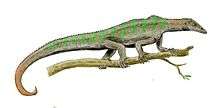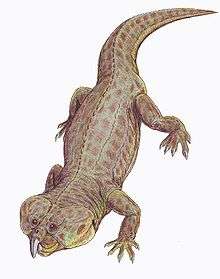Tanystropheidae
Tanystropheidae is an extinct family of mostly marine archosauromorph reptiles that lived throughout the Triassic Period. They are characterized by their long, stiff necks formed from elongated cervical vertebrae with very long cervical ribs. Some tanystropheids such as Tanystropheus had necks that were several meters long, longer than the rest of their bodies.
| Tanystropheidae | |
|---|---|
| Fossil of Tanystropheus longobardicus | |
| Scientific classification | |
| Kingdom: | Animalia |
| Phylum: | Chordata |
| Class: | Reptilia |
| Clade: | Archosauromorpha |
| Family: | †Tanystropheidae Gervais, 1858 |
| Genera[1] | |
Tanystropheids are known from Europe, Asia (Russia, China, and Saudi Arabia), North America[2] and probably South America (Brazil).[3] The presence of tanystropheids in Europe and China indicate that they lived along much of the coastline of the Tethys Ocean.[4] However, species in western North America are found in terrestrial deposits, suggesting that as a group, tanystropheids were ecologically diverse.[2]
Relationships among tanystropheid species have been difficult to resolve because most specimens were flattened during fossilization and are preserved two-dimensionally. Three-dimensional fossils are known from Europe and North America.[2]
List of genera
- †Amotosaurus
- †Augustaburiania
- †Cosesaurus
- †Dinocephalosaurus
- †Exilisuchus?
- †Fuyuansaurus
- †Gwyneddosaurus (possible chimera of Tanytrachelos and a coelacanth; thus Gwyneddosaurus is a possible senior synonym of Tanytrachelos)[5][6]
- †Langobardisaurus
- †Macrocnemus
- †Ozimek?[7]
- †Pectodens
- †Protanystropheus
- †Raibliania
- †Sclerostropheus
- †Sharovipteryx?[7]
- †Tanystropheus
- †Tanytrachelos
References
- Fossilworks
- Pritchard, Adam C; et al. (2015). "Late Triassic tanystropheids (Reptilia, Archosauromorpha) from northern New Mexico (Petrified Forest Member, Chinle Formation) and the biogeography, functional morphology, and evolution of Tanystropheidae". Journal of Vertebrate Paleontology. 35 (2). doi:10.1080/02724634.2014.911186.
- Tiane Macedo De Oliveira; Daniel Oliveira; Cesar L. Schultz; Leonardo Kerber; Felipe L. Pinheiro (2018). "Tanystropheid archosauromorphs in the Lower Triassic of Gondwana". Acta Palaeontologica Polonica. 63 (4): 713–723. doi:10.4202/app.00489.2018.
- Rieppel, O.; Jiang, D. Y.; Fraser, N. C.; Hao, W. C.; Motani, R.; Sun, Y. L.; Sun, Z. Y. (2010). "Tanystropheus cf. T. Longobardicus from the early Late Triassic of Guizhou Province, southwestern China". Journal of Vertebrate Paleontology. 30 (4): 1082. doi:10.1080/02724634.2010.483548.
- Olsen, P. E.; Flynn, J. (1989). "Field guide to the vertebrate paleontology of Late Triassic rocks in the southwestern Newark Basin (Newark Supergroup, New Jersey and Pennsylvania)". The Mosasaur. 4: 1–35.
- Olsen, P. E.; Baird, D. (1986). "The ichnogenus Atreipus and its significance for Triassic biostratigraphy". In Padian, K. (ed.). In The Beginning of the Age of Dinosaurs: Faunal Change across the Triassic-Jurassic Boundary. Cambridge: Cambridge University Press. pp. 61–87. ISBN 0-521-36779-4.
- Adam C. Pritchard; Hans-Dieter Sues (2019). "Postcranial remains of Teraterpeton hrynewichorum (Reptilia: Archosauromorpha) and the mosaic evolution of the saurian postcranial skeleton". Journal of Systematic Palaeontology. 17 (20): 1745–1765. doi:10.1080/14772019.2018.1551249.



